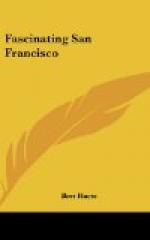San Francisco stretches for six or seven miles across the toe of the boot. Dominated by hills, the city is flanked by the Pacific on the west and by the Bay on the north and east. To the northwest, joining ocean and bay, is the Golden Gate, the only gap in the coastal mountains.
Constantinople and Rio de Janeiro have been called the only maritime cities that approach the natural beauty of situation of San Francisco. The basin of the Bay, into which the Sacramento and San Joaquin rivers pour after watering the central garden valley of the state, is an amphitheatre rimmed with peaks and ridges.
The Bay spreads out below San Francisco like an animated poster keyed in blue and silver, with Yerba Buena, Alcatraz and Angel islands tinted details in the foreground. Across the gleaming water the roofs of Oakland, Berkeley and Alameda are shingled with sun crystals, and in the distance Tamalpais and Mt. Diablo bulk against a curtain of azure.
Suavities of outline accent the horizons of San Francisco, where the skyscrapers take on fantasy as they pile up on hills and recede into vales. Most visitors cross the Bay and arrive at the city by way of the Ferry Building, the gala tower of which has a clock at each point of the compass. Travelers also arrive at the Third and Townsend street railroad station, or, if they come by sea through the Golden Gate, at the piers along the waterfront.
Market street stretches diagonally across the peninsula from the Ferry Building to the base of Twin Peaks, the urban mountain which has been tunneled to get rapid transit to residence parks.
Twin Peaks is practically the geographical center of San Francisco. By keeping this in mind visitors will avoid the mistake of thinking that the end of Market street is the western boundary of the city.
From the sweep of Market street radiate practically all of the city’s important arteries. A resplendent thoroughfare by day, 100 feet wide, Market street takes on a sorcery all its own at night, when the electroliers designed by D’Arcy Ryan, light wizard of the Panama-Pacific Exposition, flood it with radiance. Market street is then the most dazzling of boulevards, every aspect of it in motion—crowds, taxis, cars and the colors of advertising displays.
The junction formed by Market, Kearny, Geary and Third streets is the heart of downtown San Francisco. It is the newspaper center, and close by are big and little hotels, shops, restaurants and sidewalk flower stalls. Here traffic eddies around Lotta’s Fountain, presented to the city by Lotta Crabtree, stage idol of the yesteryears. Beside it is one of the bronze bells and iron standards that mark El Camino Real—the King’s Highway—which the padres trod in making their rounds of the early California missions. Lotta’s Fountain has two tablets. One has its donor’s name, and the other is inscribed to Luisa Tetrazzini, whose soprano was first acclaimed to the world from San Francisco, and who crossed the continent to sing Christmas carols to the people on this street corner in 1910. One block east, Montgomery street leads into the financial center of the Pacific. To the west are Union Square and its shaft, commemorating Dewey’s victory at Manila Bay, and Powell street, with its cafe and theatre crowds.




